In the case of the narrative universe created by J.R.R. Tolkien, the fantasy ends up escaping from that parallel line, from that passing in imaginary spaces so precisely detailed and so intensely lived to reach tangible spaces.
Reality has a subjective component through which that exuberant nature has long since filtered, those spaces outlined between dark shadows and fascinating landscapes where with precious care, Tolkien knew how to describe awakening our attention in every detail. In the end, the development of the story was as important as its location and scenery. From those powders these muds, a book for the mythomaniacs to permanently inhabit that new waiting world ...
JRR Tolkien believed that The Silmarillion was the foundation for his imagined world, but despite being the primary and central work, he was unable to bring it to its final form, and it fell to his son, Christopher, to build the latest version of a 'Silmarillion' from the stories left by his father when he passed away.
Because, starting from a closed myth, with a beginning and an end, the narrative material had come to acquire an enormous extension, with important characters emerging from the Ancient Days, among which Galadriel was the most important. Therefore, Tolkien had to do a lot of "rewriting" for The Silmarillion to have a correct relationship with The Lord of the Rings.
The writings collected in The nature of Middle Earth they show the paths Tolkien took in search of a better understanding — more precise, complete, and consistent — of his own unique creation. These writings, of different lengths, cover various topics, such as:
* The aging and action of time on the immortal and mortal beings of Middle Earth, and the surprising degree of precision and mathematical ability that Tolkien applied to achieve rigorous schemes in this regard;
* Foundational issues such as creation, life, destiny and free will, the functioning of the body and the spirit and the relationship between the two, as well as the nature of authority, the meaning of life and death;
* Vivid descriptions of the lands, animals and peoples of Númenor. * Descriptions of the physical appearance of various characters in The Lord of the Rings, including explanations of who had a beard and who did not.
All these writings reveal new and unsuspected details of Tolkien's philosophy, imagination and sub-creation, which are surprising, profound and even amusing.
This new collection, which has been edited by Carl F. Hostetter, one of Tolkien's leading experts, is a veritable treasure trove that offers readers an opportunity to look over Professor Tolkien's shoulder as he discovered new things. On every page, Middle-earth comes alive again with extraordinary force.
You can now buy Tolkien's "The Nature of Middle-earth" book here:

